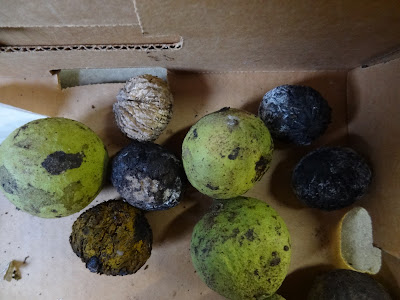 |
| Black Walnuts |
I've been collecting and hulling black walnuts to enter in the upcoming community fair. We have a pretty good crop this year and I was actually able to collect some before the critters squirreled them all away (pun intended). As you probably know, black walnuts produce a dark, persistent stain, so I wore gloves while handling them. However what I didn't realize was that the gloves had a couple of holes in them. Consequently, I ended up with two very dirty looking, stained fingers. When this has happened in the past, I just waited the several weeks it took for the stain to wear off. But this time, I thought I'd try something different since it was going to be embarrassing at work with my dirty looking fingers.
A little research revealed that people have tried everything to get rid of black walnut stain from full strength bleach to acetone. Of the many stain removers that were suggested, the only one I was comfortable with was lemon juice.
I started with just one finger. First I soaked it in the lemon juice, followed by scrubbing with a cloth soaked in lemon juice, and ended with washing it with soap and water. I repeated this cycle several times until my skin became tender. And what was the result? If you squint your eyes just right, I think the lemon juice helped a little.
I learned an important lesson from this experience. Next time, I'm going to check for holes in my gloves before I mess with black walnuts.
.JPG) |
| The stain remover that didn't work well. |
Do you gather enough walnuts for eating in your house? One of my kids was asking why we don't grow nuts here, and my reply was squirrel theft and problems with worms in the nuts. But now maybe I'll look into growing nuts here.
ReplyDeleteAs for the stained hands, for weeks in the summer and fall I look like I never wash my hands, because of the berry stains. My nails get stained the worst, so I keep them very short. A pumice stone on the sides of my fingers helps. But only so much of that, or the skin begins to feel raw. Good luck with it.
We could gather enough to eat, but we don't like black walnuts. Even if we liked them, they have one of the hardest shells around to crack. For me, nuts are too much work to crack and clean for the amount of nut that you get out. And mine always seem to have shells in them.
ReplyDeleteHowever, my father loved to gather, shell, and eat nuts. He could do it cleanly without getting too many shell fragments in the final product. So give it a try if you'd like.
Live and learn, or "June", I meant to add earlier, that I always enjoy your photography of nature. You have a eye for beauty, and I'm nominating you for the Beautiful Blogger Award.
ReplyDeleteYikes, they stain for weeks? That must be annoying. Also, it might be a silly question, but what is the difference between normal walnuts and black walnuts?
ReplyDeleteNormal walnuts or English walnuts, as some call them, have thinner shells than black walnuts. Black walnuts have a stronger taste that you either like or you don't.
DeleteBlack walnuts are native to North America and can often be found growing wild. English walnuts are native to central Asia and are cultivated more often.
You are generous to go throw all that work when you don't like to eat them. :-) All that works sounds like eating crab...except for the fact that I really like the taste of crab.
ReplyDelete